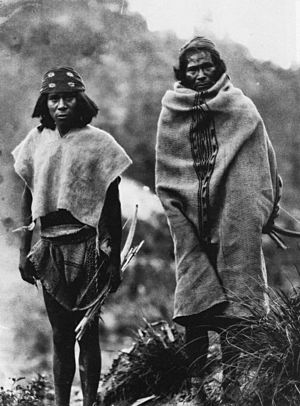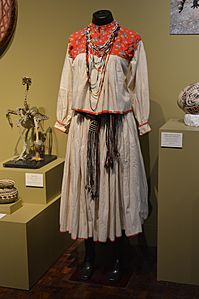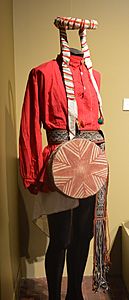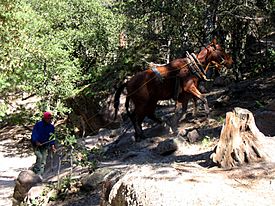Rarámuri facts for kids

Two Tarahumara men photographed in Tuaripa, Chihuahua, in 1892 by Carl Lumholtz
|
|
| Total population | |
|---|---|
| Unknown: estimates vary | |
| Regions with significant populations | |
| Mexico (Chihuahua, Durango, Sonora) | |
| Languages | |
| Tarahumara, Spanish | |
| Religion | |
| Animism, Peyotism, and Roman Catholic | |
| Related ethnic groups | |
| Suma, Guarijío, Huichol, Tepehuán, Mayo, Yaqui |
The Rarámuri or Tarahumara are a group of indigenous people of the Americas who live in the state of Chihuahua in Mexico. They are very well known for their amazing ability to run long distances.
The Rarámuri originally lived in many parts of Chihuahua. When Spanish explorers arrived in the 1500s, the Rarámuri moved to the high mountains and deep canyons. These areas include the Copper Canyon in the Sierra Madre Occidental mountain range. Today, this mountain area is often called the Sierra Tarahumara because the Rarámuri live there.
In 2006, there were an estimated 50,000 to 70,000 Rarámuri people. Most of them still live a traditional life. This includes living in natural shelters like caves or under cliff overhangs. Their main foods are corn and beans. Many Rarámuri also move their cattle, sheep, and goats to different places throughout the year. Almost all Rarámuri travel from one place to another during the year.
The Rarámuri language is part of the Uto-Aztecan language family. Even though Spanish is becoming more common, many Rarámuri still speak their language. In their language, the word rarámuri means men. Women are called mukí (one woman) or omugí or igómale (many women).
Contents
History of the Rarámuri People
The Rarámuri are thought to be descendants of people from the Mogollon culture. When the Spanish conquistadors arrived in the 1500s, they called these native people the "Tarahumara." The Rarámuri fought back and were never fully conquered by the Spanish. They also did not fully convert to the Catholic religion by Jesuit missionaries at first.
By the early 1600s, the Spanish had started mining in Rarámuri lands. They also captured some Rarámuri to work as slaves in these mines. A Jesuit missionary named Juan Fonte started a mission called San Pablo Balleza. He was working to spread Christianity from the Tepehuan people in the south to the Rarámuri. In 1616, the Tepehuan people fought back against the Spanish in a big revolt. Juan Fonte and seven other Jesuit missionaries were killed, and the mission closed for over ten years.
The discovery of mines in Parral, Chihuahua, in 1631 brought more Spanish people to Rarámuri lands. This led to more slave raids and more Jesuit missionaries. Missions were set up in places like Las Bocas, Huejotitlan, San Felipe, and Satevo. In 1648, the Rarámuri fought a war against the Spanish. They gathered at Fariagic and then destroyed the mission of San Francisco de Borja. Two of the leaders of this attack were caught and executed by the Spanish. Soon after, the Spanish built Villa de Aguilar in the middle of the upper Rarámuri country.
After this, the Rarámuri split into two groups. Those living near the lower missions slowly became part of the general Catholic population and lost much of their original identity. Those in the upper areas went to war under leaders like Tepóraca. They forced the Jesuits and Spanish settlers out of their area. The Jesuits came back in the 1670s and baptized thousands of Rarámuri. However, these Rarámuri people kept their separate identity. Tepóraca was executed by the Spanish in 1690. From 1696 to 1698, the Rarámuri fought against the Spanish again but were defeated. A key Jesuit report from 1691, called Historia de la tercera rebelión tarahumara, talked about the Rarámuri's resistance to becoming Christian.
By 1753, the Jesuits handed over the lower Rarámuri missions to other priests. In 1767, the Jesuits were forced to leave all Spanish territories. Most missions in Rarámuri country stopped working or were given to Franciscan priests. Even with their best efforts, the Franciscans could not do as much as the Jesuits, and the missions declined. The Jesuits came back and restarted the missions in the early 1900s.
Rarámuri Culture and Traditions
Amazing Athletic Skills
The Rarámuri word for themselves, Rarámuri, means "runners on foot" or "those who run fast." This is according to some early researchers like Carl Lumholtz. However, not everyone fully agrees on this meaning. Because their homes are spread out far apart, these people developed a tradition of long-distance running. They can run up to 200 miles (320 km) (about 320 km) in one go, over two days. They do this through their homeland of rough canyons for talking between villages, for travel, and for hunting.
The Rarámuri wear huaraches, which are traditional sandals, when they run. Many scientific studies and news stories have looked at this. In his book, Born to Run, author Christopher McDougall writes about the idea that humans are naturally good at long-distance running. He also supports the barefoot running movement. He based his ideas on his time with the Rarámuri people and how they run in huaraches. Rarámuri sandals have become very popular in running groups in the US. Many companies have started making similar sandals since McDougall's book made the style famous.
Their tradition of long-distance running also includes special ceremonies and competitions. Often, men kick wooden balls as they run in "foot throwing" races called rarajipari. Women use a stick and a hoop in their own races. The foot-throwing races are like relays. Runners kick the balls and pass them to the next runner. Teammates run ahead to the next relay point. These races can last from a few hours to a couple of days without stopping.
The Rarámuri often hunt with bows and arrows. They are also known for their ability to run down deer and wild turkeys. Anthropologist Jonathan F. Cassel explains how the Rarámuri hunt: "the Tarahumara literally run the birds to death in what is referred to as persistence hunting." This means they keep chasing the bird, forcing it to fly and land many times without enough rest. The heavy bird gets too tired to fly or run away from the Rarámuri hunter.
Religious Beliefs
The Rarámuri religion is a mix of their own traditions and Roman Catholicism. In the late 1600s and early 1700s, Jesuit missionaries tried hard to convert them, but the Rarámuri resisted. Later, when the Jesuits were forced to leave, the Rarámuri were free to understand and change Catholic beliefs and practices in their own way.
They kept many of their native religious ideas. But they also mixed in Spanish Catholic rituals. This shows a true blending of their cultures. The most important beings in their religion are God (Riosi), God's wife (who is like the Christian Virgin Mary), and the devil (Riablo). Riosi is thought to be their native god Onoruame ("Great Father"). The Virgin Mary is Iyeruame ("Great Mother"). Their ideas of Father-Sun and Mother-Moon also connect with God and God's wife.
Another idea is that God has a wife who lives with him in heaven. They have sons called sukristo (from Spanish Jesucristo) and daughters called Santi. These beings are connected to the physical world through Catholic symbols like crucifixes and saints’ medallions.
Even though Riablo is like the devil, the Rarámuri do not believe in a being that is completely evil. Instead, Riablo is seen as being influenced by the Chabochi (non-Rarámuri). The Devil is sometimes said to work with God to give fair punishments. People can also make the Devil happy with sacrifices. In some cases, the Devil can even be convinced to act in a good way.
Some Rarámuri religious practices involve konema, which means feeding God. This idea of giving back to God a little of what he has given them is very important.
Some Rarámuri believe that the afterlife is a mirror image of the living world. They believe that good deeds should be done not for a reward in heaven, but to make life better on Earth.
The Rarámuri, like other Uto-Aztecan tribes, also respect and use peyote in their ceremonies.
Music and Dance
Music and dance are a very important part of Rarámuri social life. The famous pianist Romayne Wheeler wrote that "Music makes every moment special in the life of all the Tarahumaras." He also said, "All of our actions have musical meaning." At the end of the year, the Rarámuri play violins. These violins are beautifully carved but not shiny. The songs are called matachín pieces. Dancers wear colorful clothes that look like North African outfits. They also use rattles called sáuraka. During Lent, they play three-holed flutes made from river cane, along with drums.
Traditional Clothing
Traditional Rarámuri dresses are shown at the Museo de Arte Popular in Mexico City:
Food and Diet
The main foods of the Rarámuri are corn, beans, greens, squash, and tobacco. In areas closer to Mexican towns, they also eat chili, potatoes, tomatoes, and sweet potatoes. Corn is planted in February and March using oxen, which are often borrowed since not everyone owns one. Corn starts to flower in August. By November, it is harvested and then cooked or stored. Common corn dishes are pinole, tortillas, atole, tamales, and boiled or roasted corn on the cob. Beans are a key food for protein and are usually fried after being boiled. Tamales and beans are common foods that the Rarámuri carry with them when they travel. Wheat and fruits were brought by missionaries and are a smaller part of their diet. The fruits they grow include apples, apricots, figs, and oranges.
The Rarámuri also eat meat, but it makes up less than 5% of their diet. Most of the meat they eat is fish, chicken, and squirrels. For special ceremonies, they eat domesticated animals like cows, sheep, and goats. The Rarámuri hunt deer and wild turkeys by persistence hunting. They follow the animal at a steady pace for one or two days until it gets too tired to move.
According to William Connors, a food researcher, the Rarámuri's traditional diet was linked to their low rates of diseases like Type 2 Diabetes. However, in areas where processed foods are replacing their traditional foods, the Rarámuri's health is changing.
Tesgüino and Tesgüinadas Festivals
Tesgüino is a traditional fermented drink made all year round from sprouted corn. Sometimes it is also made with green corn stalks, fruits from certain cactuses, shrubs, wheat, and trees when corn is scarce. The process starts by malting the corn. This means spreading it in a shallow basket covered with pine needles for four or five days. It is kept wet until the corn sprouts. During this time, the starch in the corn turns into smaller sugars. Then, it is mashed and boiled for eight hours. Various herbs are ground up and mixed with water to make a paste. This paste is fermented overnight by a fire. Then, the paste is mixed with the corn liquid and fermented for another three to four days. People usually drink the tesgüino soon after it is made, as it can spoil within 24 hours.
Gatherings for celebrations, races, and religious ceremonies often include tesgüinadas. These are like Rarámuri festivals where tesgüino is shared. These gatherings happen all year, but most often in winter. They are important social events between neighboring Rarámuri people. Tesgüinada events include rain fiestas, harvest ceremonies, healing fiestas, Guadalupe Fiesta, Holy Week, races, and Sunday gatherings. Some of these events happen during and after community work. For example, when neighbors help each other with their fields or build large structures like granaries, houses, and animal pens. The harvest and rain ceremonies happen during farming months to help ensure good crops. These events also need a shaman, curandero (healer), or chanter. The shaman and curandero have religious roles. The curandero diagnoses and heals the sick. Chanters lead the tesgüinadas with chants and rhythms for the ceremonies.
The religious role of tesgüino is a very important part of tesgüinada. Before drinking a pot (olla) of tesgüino, it must be offered to Onorúame. During healing ceremonies, the pot must sit in front of a cross until the ceremony is over. At age 14, a boy is allowed to drink tesgüino for the first time after a short talk about his responsibilities as a man. These rituals can sometimes last as long as 48 hours. Tesgüinadas usually include dancing and playing fiddles, flutes, drums, and guitars.
Notable Rarámuri People
- Arnulfo Quimare, ultra marathoner
- Carmelita Little Turtle, photographer
- Daniel Ponce de León, former WBO world junior featherweight boxing champion
- Dr. Octavio Casillas, award-winning educator
- Edwin Bustillos, award-winning agricultural engineer
- Isidro Baldenegro López, community leader and activist
- Jacob Casillas, award-winning mechanical engineer
- María Lorena Ramírez, ultra marathoner
- Mario Trejo, footballer
- Rochelle Gutierrez, professor of education
Challenges Faced by the Rarámuri
Environmental Issues
Logging, which is cutting down trees, has been happening since the late 1800s. In the 1990s, new laws made it easier to cut down trees, which led to many forests being lost. In 1995, it was said that "after hundred years of logging, only two percent (300,000 acres) of these unique forests remains." This means one of North America's most diverse ecosystems, with hundreds of medicinal plants, oak, and pine trees, is in danger. A report in 2000 noted that the government had not studied how tree cutting affected the environment. Also, the North American Free Trade Agreement (NAFTA) brought more foreign money. This led to private companies owning communal land and changes in environmental rules.
In January 2017, Isidro Baldenegro López was shot and killed in Mexico. He was a Rarámuri community leader and won the Goldman Environmental Prize in 2005. Baldenegro spent much of his life protecting the old forests of the Sierra Madre region from the harmful effects of logging.
Drought, which is a long period without rain, has also affected the region for ten years and has gotten worse recently. In 2011, it was the driest year ever recorded in Mexico. Only 12 inches of rain fell, compared to the usual 21 inches. The Sierra Madre region was hit the hardest. Farmers in Chihuahua lost an estimated $25 million. About 180,000 cattle have died because of the lack of rain.
Because of the lack of water, crops were destroyed, and hunger spread. Along with very cold temperatures, living conditions became very hard for the Rarámuri. Their dependence on the environment makes the situation worse. They do not have many job opportunities outside of farming to earn money. Also, more contact with the outside world can be harmful as it creates dependence. These indigenous people face extreme poverty. The Mexican Human Development Index (HDI) in the Sierra Madre is the lowest in the country, 49.1% below the national average. Alberto Herrera, the Mexican director of Amnesty International, said that indigenous people in his country have faced "constant discrimination, exclusion, and being pushed to the side."
Mining Activities
Mining has been done in Mexico since 950 AD by civilizations like the Toltec and Mayan. Since the Spanish arrived, thousands of tons of mercury and lead have been released in the Mexican mining belt. This belt stretches from Oaxaca to Sonora in the northwest. The Sierra Madre part of this belt is one of the world's richest areas for gold and silver mining. Georgius Agricola mentioned in 1556 that mining led to forests being cut down, animals disappearing, and water becoming polluted. Large areas were deforested to get metal deposits. Changes in laws in the 1990s allowed foreign companies to own mines. This led to mines reopening and more mining. In 2006, 204 mining companies with foreign investment had 310 projects in Mexico. In 2010, Mexico's mining output reached very high levels. 19% of the world's silver was mined there, and the mining belt was the most productive area in the world, just as it had been in the past. The effects on the environment are huge. They include changes to the landscape and the spread of heavy metals.
Forced Displacement

The dangerous conditions in their home areas sometimes force Rarámuri people to leave. They are often scared by criminal groups and mining companies, both Mexican and foreign.
Impact of Tourism
The remote mountains of the Sierra Madre have long been a safe place for the Rarámuri. However, roads and tourism have grown. This brings opportunities for some but problems for others. The Rarámuri themselves have rarely sought this public attention. In the 1800s, people tried to build a railway. Today, this train line is used by the Chihuahua Pacífico train, or El Chepe, to carry tourists. These tourists are attracted by false ideas that the area is pure and untouched. The train stops near many Rarámuri villages, bringing visitors who expect to see "primitive natives." Along with new roads, railways built into the area have led to more logging and tourism. These changes have sped up how quickly the Rarámuri's way of life is becoming more modern.
See also
 In Spanish: Pueblo rarámuri para niños
In Spanish: Pueblo rarámuri para niños
- Ivan Ratkaj
- Multiday races
- Raramuri Criollo cattle
- Tarahumara language





